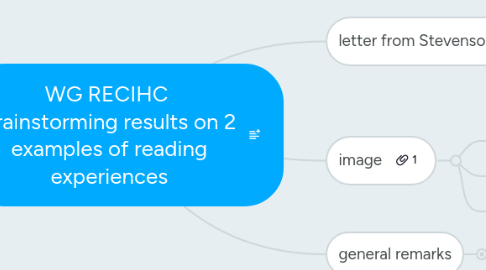
1. letter from Stevenson
1.1. group 1
1.1.1. rapporteur
1.1.1.1. stepping back at a different level
1.1.1.1.1. network of ppl related to Stevenson through letters
1.1.1.2. reference information
1.1.1.3. make it useful
1.1.1.3.1. links to database
1.1.1.4. languages & dialects
1.1.1.4.1. in the letter
1.1.1.4.2. referenced in the writing
1.1.1.5. physical descriptions
1.1.1.5.1. colours
1.1.1.5.2. portrait
1.1.1.6. material
1.1.1.6.1. public
1.1.1.6.2. private
1.1.1.7. "living book"
1.1.1.7.1. how to deal with this expression ?
1.1.1.8. advisor
1.1.1.8.1. vocabulary ?
1.1.1.8.2. personal
1.1.1.8.3. professional
1.1.1.9. tricker informations
1.1.1.9.1. quotations
1.1.1.10. repeated words
1.1.1.10.1. "angel"
1.1.1.10.2. references
1.1.1.11. names
1.1.1.11.1. author
1.1.1.11.2. works
1.1.1.12. date
1.1.1.13. location
1.1.1.13.1. places
1.1.1.14. author
1.1.1.15. genre
1.1.2. questions
1.1.2.1. direct or indirect informations on the book structures or on a part
1.1.2.2. need to specialized vocabularies
1.2. group 2
1.2.1. text rather difficult to understand
1.2.2. rapporteur
1.2.2.1. relation between reader/writer
1.2.2.1.1. intimacy, complicity
1.2.2.1.2. friendship
1.2.2.2. elegance
1.2.2.3. presence of understatement
1.2.2.4. peer exchange
1.2.2.4.1. both readers
1.2.2.4.2. both writers
1.2.2.5. attitude
1.2.2.5.1. describing this experience
1.2.2.5.2. evaluation
1.2.2.5.3. gratitude
1.2.2.6. general reflexion on reading
1.2.2.6.1. on the act itself
1.2.2.6.2. not on a particular part
1.2.2.7. describing the reading context
1.2.3. remarks
1.2.3.1. lot of encoded informations
1.2.3.2. we need to establish how to describe those meta informations about the reading exp
1.3. group 3
1.3.1. rapporteur
1.3.1.1. letter
1.3.1.2. necessary informations
1.3.1.2.1. published ?
1.3.1.2.2. handwritten or typewrited ?
1.3.1.3. relationship between author & recipient
1.3.1.3.1. complicity
1.3.1.3.2. money
1.3.1.4. if published
1.3.1.4.1. bibliographical informations
1.3.1.5. former existant analysis ?
1.3.1.6. information in the document
1.3.1.6.1. place
1.3.1.7. implicit informations
1.3.1.7.1. title of the text he's mentioning
1.3.1.8. underlined parts
1.3.1.8.1. vocabulary
1.3.1.8.2. some words are CAPITALIZED
1.3.1.9. other languages
1.3.1.9.1. used by the reader
1.3.1.9.2. using mixed languages inside a single document
1.3.1.10. work on sources
1.3.1.10.1. the group working must be multilingual, and multicultural => one must be native
1.3.1.10.2. be able to understand implicit informations
1.3.2. remarks
1.3.2.1. place
1.3.2.1.1. if very precise informations, important to mention it
2. image
2.1. group 4
2.1.1. rapporteur
2.1.1.1. 7 points
2.1.1.2. jean-francois = author
2.1.1.2.1. context information
2.1.1.3. caption ?
2.1.1.3.1. method
2.1.1.3.2. already there ?
2.1.1.3.3. introduce a character ?
2.1.1.3.4. anonymous
2.1.1.4. levels of engagement in reading
2.1.1.4.1. examples
2.1.1.4.2. way of reading => full european vocabulary
2.1.1.5. language scripto-visual
2.1.1.5.1. need of semiotic tools
2.1.1.5.2. necessity of a category
2.1.1.6. datas around the object
2.1.1.6.1. context
2.1.1.6.2. zooming in as a method
2.1.1.6.3. image recognition tool ?
2.1.1.7. readable environment
2.1.1.7.1. framed images in front of the cinema
2.1.1.7.2. but
2.1.1.7.3. least apparent sign
2.1.1.8. H2020
2.1.1.8.1. reading objects => in the vogue
2.1.1.9. challenges
2.1.1.9.1. reading & writing in public space
2.1.1.9.2. photographs in press
2.1.1.9.3. languages as sthg breaking the barriers in Europe
2.1.1.9.4. collective & metareading experiences
2.1.2. remarks
2.1.2.1. illeteracy ?
2.1.2.2. reader or flaneur ?
2.2. group 5
2.2.1. rapporteur
2.2.1.1. need of definitions
2.2.1.1.1. what is a reader ?
2.2.1.1.2. what is a reading experience ?
2.2.1.2. most of the time
2.2.1.2.1. connected to reading experience described in texts
2.2.1.2.2. is this image a reading experience ?
2.2.1.3. context
2.2.1.3.1. who took it ?
2.2.1.3.2. when ?
2.2.1.4. 1. describing picture
2.2.1.4.1. lack the context
2.2.1.4.2. in the street, public
2.2.1.4.3. determine if the subject is a man
2.2.2. remarks
2.2.2.1. "modes" of reading
2.3. group 6
2.3.1. image
2.3.1.1. important to have the reader inside the image ?
2.3.1.2. having a book in a hand isn't enough to char
2.3.2. what type of doc ?
2.3.3. what is being read ?
2.3.4. where ?
2.3.5. when ?
2.3.6. how ?
2.3.7. need of broad categories
2.3.8. direction of reading
2.3.8.1. top/down
2.3.8.2. left to right
2.3.9. intentional or incidental reading ?
3. general remarks
3.1. we have not examine many supports
3.1.1. discuss reading
3.1.2. audio
3.1.3. ...
3.2. to answer the needs of material
3.2.1. leading to data fields
3.2.2. way to organize ourselves
